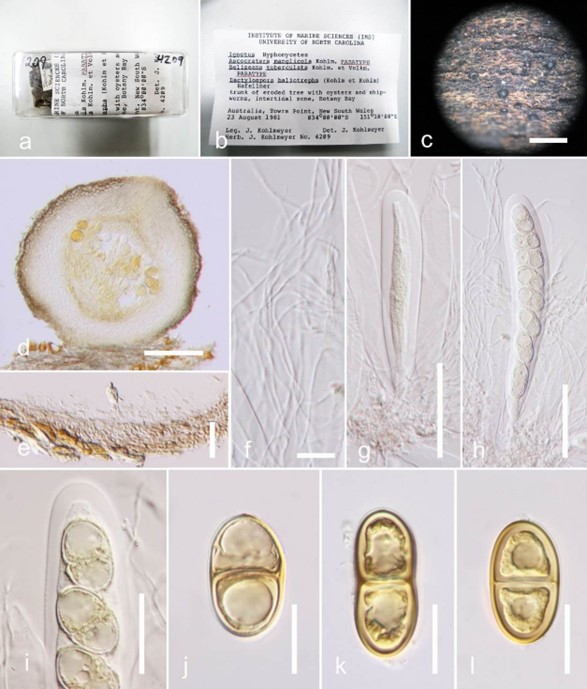Belizeana tuberculata Kohlm. & Volkm.-Kohlm., Bot. Mar. 30(3): 196 (1987) Fig. 6
MycoBank number: MB 130737; Index Fungorum number: IF 130737; Facesoffungi number: FoF 06219;
Pathogenic or saprobic on Laguncularia sp. Sexual morph: Ascomata 165–310 μm high × 155–295 μm diam., solitary, scattered, or clustered or somewhat gregarious, erumpent, subglobose, medium-sized, dark brown to black, pale brown on the sides, ostiolate, epapillate or shortly papillate. Peridium 25–35 μm wide, comprising a few layers of thin-walled cells of textura angularis, hyaline towards the inside, basal region giving rise to hyaline hyphal mass producing asci. Hamathecium of dense, ca. 2 μm broad, filliform pseudoparaphyses, rarely branched, embedded in gelatinous matrix. Asci 135–160 μm × 20–30 μm ( x = 163 × 25 μm, n = 10), 8- spored, bitunicate, fissitunicate, broadly cylindrical to clavate with a short pedicel, thick-walled, rounded at apex with an ocular chamber. Ascospores 21–26 μm × 13–18 μm ( x = 22 × 15 μm, n = 10), uniseriate, partially overlapping, broadly ellipsoidal, hyaline when immature, pale brown to chestnut when mature, 1-septate, constricted at the septum, thick-walled, 2-layered, mature spores.
Material examined – AUSTRALIA, New South Wales, Towra Point, Botany Bay, trunk of eroded tree with oysters and shipworms, intertidal zone, 23 August 1981, L. Kohlmeyer (IMS Herb. J. Kohlmeyer No. 4209, paratype).
Economic significance – The genus Belizeana comprises marine fungi and was reported to cause leaf spots and diseases of Rhizophora mucronata (Rhizophoraceae) (Ossler 2010).

Figure 6 – Belizeana tuberculata (IMS from Herb. J. Kohlmeyer No. 4209, paratype) a–c Herbarium specimen and habit on substrate. d Section of an ascoma. e Peridium f Hamathecium. g–h Asci. i Ocular chamber. j–l Ascospores. Scale bars: c = 1 mm, d, g, h = 100 μm, e, f = 20 μm, , i = 50 μm, j–l = 10 μm.
